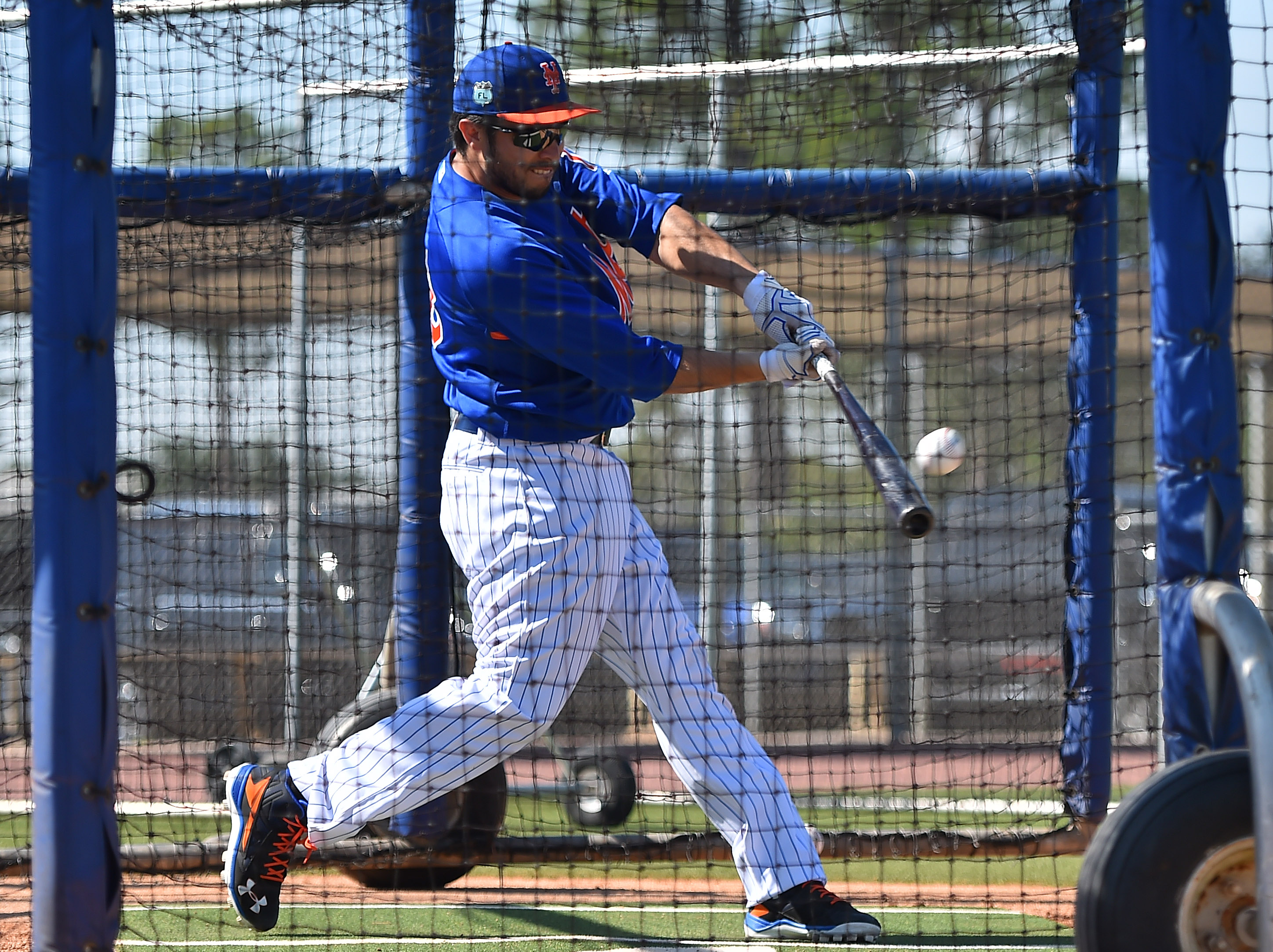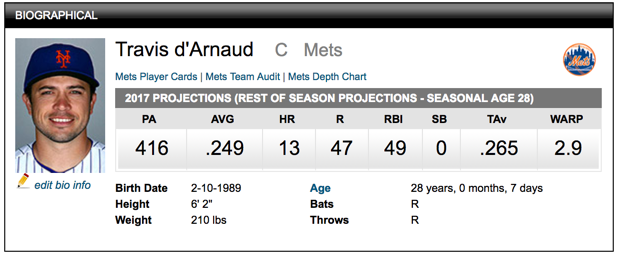Ask any Mets-watcher at the end of last season, and they might’ve told you that the team’s Achilles heel was the catcher position. Not only has Kevin Plawecki played his way from top prospect to offensive cipher, but the (original) centerpiece of the famous R.A. Dickey trade completely cratered after a breakout-but-shortened 2015 surge. Travis d’Arnaud played poorly enough–when he was healthy enough to play–to be unseated as the starter in September and October by Rene Rivera, a player picked up for free at the start of the season because no one wanted him. Make no mistake, Rivera’s a better-than-fine backup, but his rise to the starting role had nothing to do with him and everything to do with d’Arnaud.
When Baseball Prospectus’ PECOTA projection system rolled out for this new year, who did it pick to be the second-best position player on the Mets? That’s right, with more WARP per plate appearance than Yoenis Cespedes, that honor goes to TdA. Despite his sketchy 2016 performance, the deadly accurate wise and just projection system posits that d’Arnaud will be the seventh-most-valuable among all big league catchers. If we were back in February 2016, I might’ve been less surprised. After all, BP’s value metric WARP gave d’Arnaud credit for four wins despite just 268 plate appearances during the team’s magical 2015 run. Last year, even as d’Arnaud spent time on the shelf with a busted shoulder and couldn’t hit a lick when he was on the field, WARP took a rosier view than most, giving him 1.5 wins above replacement.
Going into the 2017 season, here is the simplest version of what PECOTA projects for this 28-year-old’s season:
To be clear, that’s projecting about 110 games at catcher, nine more dingers than last season, and an overall batting mix that corrects to a .265 True Average. That TAv is slightly better than average for any position player, and quite a bit better than what most catchers can put up. (For reference, last season only 16 backstops with more than 200 PA hit that well.)
Before we go any further, I’d like for everyone to remember one thing: PECOTA tends to be conservative, and the numbers here are referring to the 50th percentile outcomes. Yes, players will over- and under-shoot these projections, but PECOTA’s going to take the via media. In some cases, you could call PECOTA conservative, avoiding the highest highs and lowest lows. Let me just say that one more time, for emphasis. PECOTA thinks that Travis d’Arnaud being a top-10 catcher in baseball is the rather “safe” projection.
A three-win catcher is a very, very good thing. Jonathan Lucroy, generally considered one of the top three or five catchers in baseball, is projected for just 3.7 WARP in 2017 as an everyday player. But with the system only giving TdA 65 percent of the Mets’ catching reps–about 415 plate appearances–the embattled backstop becomes one of the finest twos in the game. There are three main factors that underpin d’Arnaud’s projection and each of them are open to some debate.
Defense
The first and simplest factor is defense … especially when it comes to pitch framing. d’Arnaud’s framing is the one thing that (I think) we can rely on. When TdA is behind the plate, he is going to grab extra strikes and therefore extra value, and he can do this despite receiving some of the hardest-throwing pitchers in the game. Now, there are some people that question framing’s absolute value … that is, is it really as valuable as Baseball Prospectus says it is? This is the wrong place to litigate that question, but I believe that the research speaks for itself, and the answer is yes. However, the rest of catcher defense isn’t kind to our top receiver. He’s abjectly bad at controlling the running game–the metrics at BP, scouts, and the random eye test all seem to agree–and pitch blocking isn’t his thing at all, though he made some small strides last season. Add that to the fact that he doesn’t seem to get the plaudits that Rene Rivera does when it comes to calling a game and handling the staff, and one might start to empathize with those who think that he may not be a full win better than average over two-thirds of a season when taking into account the whole catcher defense package. (I think he is, but I can at least understand the argument against.)
Offense
The second factor is offense, and this is where projecting starts to get complicated. No one thinks that Travis d’Arnaud is as bad of a hitter as he appeared last season, but videotape doesn’t lie. He was bad, and he sucked. Looking briefly at some of the stats behind his disappointing .239 True Average, we can see that one of the biggest deltas between his killer 2015 and his killer-but-this-time-we-mean-the-opposite-thing 2016 was in his rate of contact on balls outside of the strike zone.
Pitchers didn’t seem to treat d’Arnaud all that much different on the whole, pumping about 51 percent of all pitches in the strike zone, about in line with previous seasons. And while d’Arnaud didn’t swing more frequently at balls outside of the zone, he made contact with those pitches much more often. Instead of making contact on 58 percent of pitches out of the zone, he made contact with 76 percent of those pitches.
It may be crazy to think that you’d want a player to swing and miss more often, but that’s exactly what I think hurt d’Arnaud last year from a statistical perspective. Making contact on balls out of the zone can be great if you’re a scrappy squib-hitter with speed or a bat-control freak of nature like Pablo Sandoval or Vladimir Guerrero. That isn’t d’Arnaud’s game; he’s a guy with doubles-power who needs to wait for a pitch to drive and belt it. Instead, d’Arnaud’s ground ball rate shot up, and as we’ve learned over the past few years, the best way to be a good hitter is to put the ball in the air. In addition to his ground ball rate rising from 37 percent in 2015 to 52 percent in 2016, he also “barreled” only seven balls this last season (per Statcast’s metric designed to identify the best possible contact) compared to 12 barrels in 2015.
From a numbers standpoint, it would certainly behoove TdA to swing at fewer pitches outside the zone if he’s going to make poor contact like he did this past season. Hopefully this is something of an outlier, a trick of his 2016 performance that perhaps resulted from a shoulder injury that kept him from driving the ball. With rest and recovery, it’s possible that he could bounce back to a well-above-average rate of production, though a repeat of 2015’s rates is probably out of the question.
Health
For his entire career, the big question about d’Arnaud has been his health. There have been a litany of issues with his body, most recently the previously-noted rotator cuff issue, but also including injuries to his back, foot, brain, hand, and elbow. Many of these have been what we call “freak” injuries–ones that aren’t part of a chronic issue or weakness, but rather result from unplanned contact such as getting brained by a backswing or breaking a hand because it was hit by a pitch. That’s great, and it tends to give one the hope that this will be the year that he stays healthy … but there’s just as good of a chance that he’s just slightly more fragile than your average catcher.
The unfortunate truth is that d’Arnaud just doesn’t possess a history of staying healthy, and that’s the biggest indicator that he won’t be healthy in the future. That BP projects 416 plate appearances is wonderful, but there’s a reasonable chance he won’t make it that far … after all, when you factor in minor-league time, there have only been three seasons in his career (2009, 2011, and 2014) where he’s seen that many PAs. Health factors also prevent d’Arnaud from getting the consistent playing time that would benefit his development, and allow him the comfort that many players demand in order to perform at their highest level. (This also doesn’t even take into account what might happen if he misses time with injury and Terry Collins falls in love with Rene Rivera all over again, giving away d’Arnaud’s starting spot.)
While his defense is very likely to be good, and his offense has the potential to be good, health is the fulcrum on which all of d’Arnaud’s performance rests. If he remains injury-free for a full season, terrific … I’d put good money on him reaching his 50th percentile PECOTA projection. If he can’t–which I’d give better than even odds on happening–then floor and ceiling both dip lower than the projection system might hazard.
* * *
On a recent episode of For All You Kids Out There, Jarrett and Jeff talked a little bit (again) on how if you have a good-but-not-great team, you want them to at least be a high-variance team. That way, there’s enough upside to take you to the promised land, and if things don’t work out … hey, the drop from the middle to the basement doesn’t seem so bad. The Mets are certainly that high-variance team and d’Arnaud is certainly the team’s most high-variance player. He could get off to a hot start, push Rivera to a true backup role, hit like 2015, and most importantly stay healthy. If that happens, the Mets should be glad they didn’t trade for Jonathan Lucroy last year, because they already have a better version. (That’s right, I said it.)
But that’s not likely. That’s the 90th percentile-plus outcome. The 10th percentile outcome is the hitter d’Arnaud was last year, or worse, and he hardly plays because he’s bad and/or injured. There’s a three-and-a-half-win swing between the 90th and 10th percentile projections, but that’s probably a bit too conservative; as good as his defense is, there’s the possibility that he could be replacement-level or not even take the field.
If you listen to PECOTA, the great middle road, you should still be on the side of d’Arnaud over any other option the Mets can throw out there, as well as most everyone else on planet earth capable of donning a chest protector. If you listen to Jeff and Jarrett, you want players who are capable of greatness even if they’re also capable of breaking your heart. The PECOTA numbers don’t lie, and they don’t even dissemble–Travis d’Arnaud is still the kind of talent capable of being a top-tier talent at the game’s most demanding position. Terry Collins–not to mention every Met fan out there–has to let go of the fear of TdA becoming the player he was last season, and embrace the possibility that his middle road might be more than good enough.
Photo Credit: Jasen Vinlove-USA TODAY Sports



2 comments on “T-D-A and P-E-C-O-T-A”
Comments are closed.